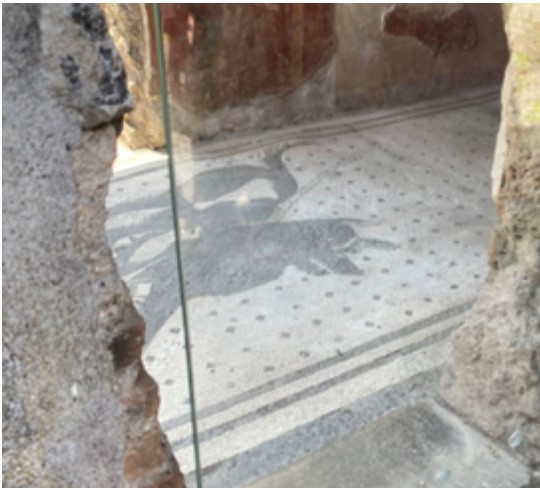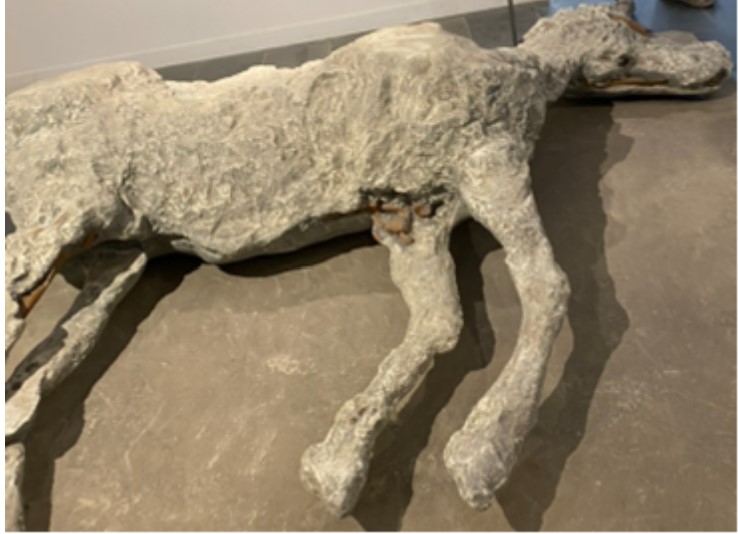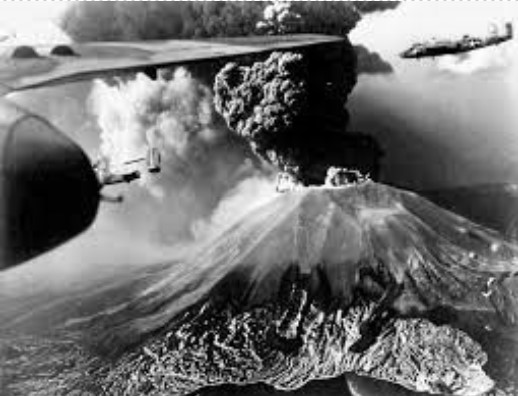Tags
BGSU History, BGSU Study Abroad, Casey Stark, Jo Enger Arthur Scholarship for Study Abroad, Pompeii, Roma Aeterna, Rome, Sabrina Sprague, Undergraduate
By: Sabrina Sprague, BGSU Roma Aeterna 2023 Student
“Grey clouds roll over the hills Bringing darkness from above but if you close your eyes Does it almost feel like nothing changed at all?” (Bastille 2013). For many people, there is more to Pompeii and the Bay of Naples than the eruption that led to the disappearance of Pompeii. That eruption preserved Pompeii and has allowed research in several disciplines to interact including those of archeology, history, classical studies, and geology to learn about the past. Thus, Pompeii has become a major site for interdisciplinary research and results.
79 CE: The Eruption of Mount Vesuvius
Pompeii was one of the many cities in the Bay of Naples region which fell under the control of the Roman Empire. From the view of those who inhabited the region, it would have been a perfect location to develop into a civilization. There was access to the sea, fertile farmland, and even beautiful scenery (Figure 1). However, no one would have known that Mount Vesuvius was a volcano since its last eruption is estimated to have been circa 1500 BCE (Giardino 2005). The eruption was a surprise to not only those who lived in the area, but also to Rome.
At the time of eruption, Titus was emperor of Rome. While he did send help to the Bay of Naples region, there was not much that could have been done (Martin 2012). Thus, Pompeii remained covered in volcanic material for centuries. It was not until the mid-eighteenth century that Pompeii was rediscovered (Frazar 1906). Art and casts of those who died during the eruption of Vesuvius have since been used in determining information about life in Pompeii.
As one of the most well-known events, the eruption that destroyed Pompeii and other cities in the Bay of Naples region has been highly researched. Many sources discuss a written account of the eruption in 79 CE. Pliny the Younger was only a teenager when Mount Vesuvius erupted. Struck with curiosity and for his career as a military leader, Pliny’s uncle made his way to the mainland (Pliny 1963). Two days later, “his body was found intact and uninjured, still fully clothed and looking more like sleep than death,” (Pliny 1963). Pliny’s letters to Cornelius Tacitus also tell of what Pliny himself saw. He describes an “umbrella pine” cloud that he found unusual (Pliny 1963). Today, this sort of cloud would be described as a mushroom cloud. Pliny’s account provides a description of the eruption but there is one aspect of the letters that is debated because of new findings.
In his letters, Pliny states that the eruption began on August 24th in 79 CE (Pliny 1963). However, recent evidence suggests that the eruption occurred in October. Charcoal writing left on the walls of a building depicts a date later than August: “The sixteenth day before the kalends of November, he indulged in food in an immoderate way,” (Doronzo 2022). Based on the way the Romans recorded dates, this would place the eruption as occurring after 17 October. Even before this writing was found, other evidence suggested that the eruption occurred later than August. Geologic stratigraphy reveals that the deposition of the volcano’s ash is consistent with the wind patterns during the fall and winter rather than summer as suggested by Pliny’s August dating (Doronzo 2022). Cross comparing historical sources and scientific ones show that Pliny the Younger’s date was not accurate.
Preserving Pompeii
From mosaics to paintings, art preserved by the volcanic material that spewed from Mount Vesuvius are what often defines the buildings of Pompeii. Many sites such as the House of the Tragic Poet and the House of the Vettii are known for the artwork found inside. In some cases, the artwork helps to understand who may have lived there. Other sites have artwork that reflects life in Pompeii.

First, consider the House of the Tragic Poet. This location is famed for its mosaic at the original entrance which includes the image of a dog and a warning reading “Cave Canum,” or “Beware of Dog,” (“A Guide to the Pompeii Excavations”). Mosaics, not only at Pompeii, often display mythological figures or scenes so this dog mosaic stands out. Additionally, the inside of the house once contained several other artworks that display mythological scenes. Many of these scenes are from Homer’s Iliad (Bergmann 1994). This alludes to Greek influence on Romans as Homer was a Greek writer whose poems tell of Greek heroes. Because of theses panels and what they portray, the house received the title “The House of the Tragic Poet,” (Bergmann 1994). It is possible that whoever lived at this site had a deep interest in Homer’s literature, but it should be remembered that religion was a major pillar in the life of Ancient Romans.

Like the House of the Tragic Poet, excavation of the House of Vettii have revealed mythological artwork. Cupids are figures that tend to appear in mythological imagery. In one room off of an atrium, several panels with a black background display Cupids participating in several activities. The depictions include drinking wine, chariot-racing, and metal-working (Monteix 2016). Analyzing these activities reveal some of the tasks that people completed in Pompeii. Within the House of the Vettii, there are several other examples of artwork, but the Cupids frieze especially provide an insight into the lives of Pompeiians.
Later Destruction and Modern Media
Excavations have been successful in discovering new buildings and art throughout the city of Pompeii. However, Pompeii is more well known for the people that died during the eruption. Some died from the ash and lack of oxygen while others were killed when their roofs fell in. The way in which different people died affected their preservation; skeletons remain in both scenarios of injury and asphyxiation. However, the famed casts are not the bodies themselves. During excavations, cavities were found where bodies once were. The cavities were then filled with plaster and/or resin to create castings (Bergmann 2006). These casts were then dug up and examined.
Overtime, some of these castings and remains have been popularized in media such as the lovers that inspired the movie Pompeii (Anderson 2014). The Fugitives, a set of 13 casts, have also become popular recently because of new research involving forensics and x-ray imaging techniques to determine if past ideas about the Fugitives were correct (Finney 2019). In addition to films, Pompeii has become an inspiration for music like Bastille’s song “Pompeii” (2013) and video games such as “Darkest of Days” (8monkey Labs, 2010). While Pompeii has been popularized, it should be remembered that the city was the final resting place for many people.
In addition to new interpretations and research that has been presented in media, Pompeii has experienced destruction since the 79 CE eruption. During World War II, the Allied forces bombed Italy as part of the efforts to release the country from the control of dictatorship. Pompeii was one of the sites that was bombed. There was great damage to the site and several structures had to be rebuilt (Ball, Dobbins 2017). Further, Vesuvius has erupted many times since that of 79 CE. The most recent was in 1944 and captured by bombers in the area (Figure 5). New eruptions have added to the already several layers of sediment and volcanic material and possibly recovered previously uncovered areas. While Pompeii is largely excavated, several events have occurred that have affected the excavation process.
Experiencing Pompeii and Conclusion
When one goes to Pompeii, there is much that can be experienced. Whether one explores the large villas or head towards the amphitheater, those who go to Pompeii learn about the people who once lived there as well as the geologic past of the region. In some cases, Pompeii can mean more to people than what they can learn in books. Pompeii is what introduced me to my interests in history and geology and this was an experience that I would never give up. I would recommend going to anyone considering it because reading about the location does not paint the entire picture.
Pompeii is an example of why multiple disciplines are required to understand the past. History, archeology, geology, linguists, and more fields have aided in the research at Pompeii. Today, said research continues as Pompeii is excavated more and new techniques are used. Ultimately, Pompeii demonstrates that we can continue to learn and update what we know about the past.
Works Cited
“12th AF Mitchells Pass Mt. Vesuvius on Way to Bomb Enemy.” The National WWII Museum (1944).
Anderson, Paul W.S.. Pompeii. Sony Pictures Entertainment (2014).
Ball, Larry F., and John J. Dobbins. “Pompeii Forum Project: Excavation and Urbanistic Reappraisals of the Sanctuary of Apollo, Basilica, and Via della Fortuna Neighborhood.” American Journal of Archaeology 121, no. 3 (July 2017): 467-503.
Bastille. Dan Smith. “Pompeii.” Bad Blood. Santa Monica, CA: Universal Music Publishing Group (2013).
Bergmann, Bettina. “Museum Review: Final Hours: Victims of Vesuvius and Their Possessions.” American Journal of Archaeology 110, no. 3 (July 2006): 493-501.
Bergmann, Bettina. “The Roman House as Memory Theater: The House of the Tragic Poet in Pompeii.” The Art Bulletin 76, no. 2 (June 1994): 225-256.
“Darkest of Days.” 8monkey Labs. Phantom EFX. Steam (February 2010).
Doronzo, Domenico M., et. al. “The 79 Eruption of Vesuvius: A Lesson from the Past and the Need of a Multidisciplinary Approach for Developments in Volcanology.” Earth-Science Reviews 231 (August 2022).
Finney, Ben. “Pompeii: Secrets of the Dead.” National Geographic (2019).
Frazar, Mae D.. “Excavating Pompeii.” The Journal of Education 63, no. 19 (10 May 1906): 512-513.
Friedland, Elias A.. “Pompeii and the Roman Villa: Art and Culture around the Bay of Naples. An Exhibit at the National Gallery of Art, Washington D.C..” Near Eastern Archaeology 72, no. 1 (March 2009): 55-59.
Giardino, Claudio. “The Island of Capri in the Gulf of Naples Between the 5th and the 2nd Millennium BC.” Ed. Peter Attema, et. al.. Papers in Italian Archaeology VI: Communities and Settlements from the Neolithic to the Early Medieval Period. Oxford: Archeopress (2005): 625-632.
“A Guide to the Pompeii Excavations.” Board of Cultural Heritage of Pompeii (2015).
Jonas, Nicholas F.. “Pliny the Younger’s Vesuvius ‘Letters’ (6.16 and 6.20).” The Classical World 95, no. 1 (Autumn 2001): 31-48.
Macadam, Alta, and Annabel Barber. Blue Guide Rome. Somerset: Blue Guides Limited (2020).
Martin, Thomas R. Ancient Rome: From Romulus to Justinian. New Haven: Yale University Press (2012).
Monteix, Nicolas. “Perceptions of Technical Culture Among Pompeian Elites Considering the Cupids Frieze of the Casa dei Vettii.” (2016).
Pliny the Younger. The Letters of the Younger Pliny. Trans. Betty Radice. London: Penguin Classics (30 August 1963).
Sigurdsson, Haraldur, Stanford Cashdollar, and Stephen R.J. Sparks. “The Eruption in A.D. 79: Reconstruction from Historical and Volcanological Evidence.” American Journal of Archaeology 86, no. 1 (January 1982): 39-51.
Sprague, Sabrina. Pictures from Pompeii, (28 May 2023).



